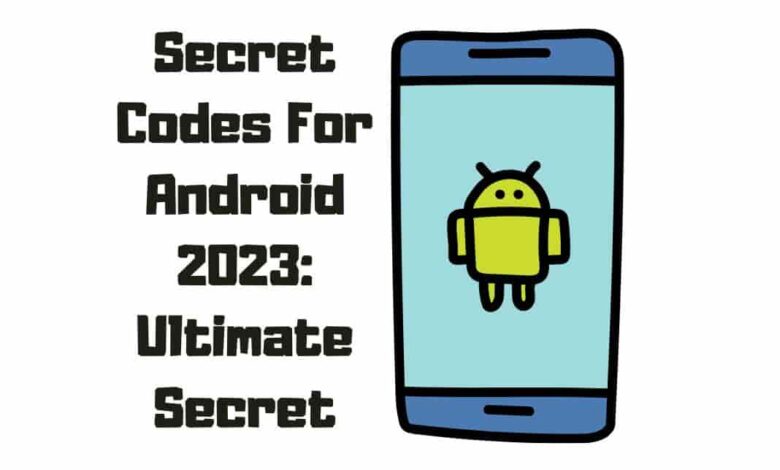Secret Codes For Android 2023: Ultimate Hacks

If you’re a tech freak, there’s a decent chance you’re familiar with most of the hidden codes for smartphones, particularly the ones that begin with “*#.” For unfamiliar people, mobile phones have long included secret codes that may be utilized to access intriguing hidden applications and settings. The majority of these Android secret codes can be divided into two categories: USSD and MMI codes. On the other hand, these hidden numbers may be used occasionally out of curiosity. This article aims to provide a comprehensive list of these secret codes for android.
Before we get started, it would be beneficial to understand what these markings mean and how MMI and USSD differ.

USSD Codes
USSD is a text message protocol allowing users to perform specific tasks on their mobile phone. These tasks include checking the amount of airtime credit, registering for services, and viewing price information.
“USSD” refers to Unstructured Supplementary Service Data, usually used to communicate between your smartphone and your mobile network operator. This also implies that you’ll almost always need to be connected to your carrier for USSD codes to function.
USSD Android codes were formerly employed to start and stop various value-added services. They were also helpful in advising you about your data usage and prepaid balance and providing access to different carrier-specific information.
While smartphone enthusiasts still use USSD codes, they have largely fallen out of favor with general consumers because most carriers offer their phone app /website where most of this information can be found. Because they are usually carrier-specific, most will vary from one network to the next. You must contact your provider for the specific ones that apply to you.
MMI Codes
MMI codes are for entering commands in phones. One example of an MMI code is *#06#, which shows your IMEI number on most phones. Other standard MMI numbers are *#*#4636#*#*, showing how much free space is left on your phone’s memory.
MMI codes are used to identify smartphones. These are part of the Man-Machine Interface schema, often used to different smartphone manufacturers or models. MMI allows you to access various hidden features on your phone, including your IMEI phone number and SAR values, as well as secret menus that smartphone engineers and repair shops typically utilize.
For example, several smartphones offer users the option of entering an MMI code to access a “test” menu. This menu allows customers to run various tests on their smartphone, including camera and vibration motor checks and speaker and display checks.
There are only a few MMI codes that work on all Android smartphones. The most common ones can be found in the following list, which includes the most popular ones.
Secret Codes for Android Devices

They’re all generally international codes and should operate on any Android device, regardless of the manufacturer. There could be carrier limits on some codes. However, they’re not necessarily guaranteed to operate.
Android Secret codes
| CODE | FUNCTION |
| *#06# | Show phone’s IMEI |
| *#07# | Displays the Specific Absorption Rate (SAR) value of the device |
| *#67# | Call forwarding |
| *#*#426#*#* | Google Play Services info or Firebase Cloud Messaging diagnostics (Select devices only) |
| *43# | call waiting |
| *#0*# | General Test Mode (Select devices only) |
| *#*#4636#*#* | battery information (Select devices only) |
| *#*#34971539#*#* | Camera firmware (Select devices only) |
| *#*#1111#*#* | FTA software version (Select devices only) |
| *#*#1234#*#* | PDA software version |
| *#12580*369# | Software and hardware info |
| *#7465625# | Device lock status |
| *#*#232338#*#* | MAC address |
| *#*#2663#*#* | Touchscreen version |
| *#*#3264#*#* | RAM version |
| *#*#232337#*# | Bluetooth address |
| *#*#2222#*#* | Hardware version |
| *#*#44336#*#* | Software version and updated info |
| *#*#273282*255*663282*#*#* | Backup all media files |
Testing codes
| Code | Function |
| *#*#197328640#*#* | Field Test mode, which also gives info about the manufacturing date |
| *#*#232339#*#* | Wi-Fi test |
| *#*#0842#*#* | Brightness and vibration test |
| *#*#2664#*#* | Touchscreen test |
| *#*#232331#*#* | Bluetooth test |
| *#*#7262626#*#* | Field test |
| *#*#1472365#*#* | GPS quick test |
| *#*#1575#*#* | Full GPS test |
| *#*#0283#*#* | Packet loopback test |
| *#*#0*#*#* | LCD test |
| *#*#0289#*#* | Audio test |
| *#*#0588#*#* | Proximity sensor test |
Configuration codes
| Code | Function |
| *#9090# | Diagnostics settings |
| *#301279# | HSDPA/HSUPA settings |
| *#872564# | USB logging settings |
Developer codes
| Code | Function |
| *#9900# | System dump mode |
| ##778 (+green/call button) | EPST menu |
Manufacturer-specific codes
| Samsung Galaxy codes | |
| Code | Function |
| *#0*# | Access diagnostics |
| *#011# | Local Network details and serving cell information |
| *#0228# | Battery status |
| *#0283# | Loopback Test menu |
| *#0808# | USB Settings |
| *#1234# | Software version/ Model details |
| *#2663# | Firmware information (Advanced) |
| *#7353# | Quick test menu |
| *#9090# | Advanced debugging tools |
| *#9900# | SysDump |
| *#2683662# | Service mode (Advanced) |
| *#34971539# | Camera firmware details |
| Xiaomi Codes | |
| Code | Function |
| *#*#64663#*#* | Access test menu |
| Realme codes | |
| Code | Function |
| *#800# | Feedback menu |
| *#888# | Engineer mode – displays PCB number |
| *#6776# | Software version |
| OnePlus codes | |
| Code | Function |
| *#66# | Encrypted IMEI |
| *#888# | Engineer mode – displays PCB number |
| *#1234# | Software version |
| 1+= (In-stock calculator app) | Displays ‘NEVER SETTLE’ on the calculator app |
| *#*#2947322243#*#* | Wipes internal memory |
| Asus codes | |
Code |
Function |
| *#07# | Regulatory labels |
| .12345+= (In calculator) | Open engineering mode |
| Motorola | |
| Code | Function |
| *#*#2486#*#* | Opens engineering mode |
| *#07# | Shows regulatory information |
| ##7764726 | Hidden Motorola Droid menu |
| HTC | |
| Code | Function |
| *#*#3424#*#* | HTC test program |
| ##786# | (Caution!) Phone reset menu |
| ##3282# | EPST menu |
| ##3424# | Diagnostic mode |
| ##33284# | Field test |
| ##8626337# | Launch Vocoder |
| *#*#4636#*#* | HTC info bar |
| Sony codes | |
| Code | Function |
| *#*#73788423#*#* | Access service menu |
| *#07# | Certification details |
| Nokia codes | |
| Code | Function |
| *#*#372733#*#* | Open service menu (FQC Menu) |
| Other codes | |
| Code | Function |
| *#7780# | Factory reset (Caution!) |
| *2767*3855# | Full factory reset (Caution!) |
| *#*#7594#*#* | Power off the phone |
| *#*#8351#*#* | Activate dialer log mode |
| #*#8350#*#* | Deactivate dialer log mode |
USSD code for US carriers
The strings you want are not top-secret but aren’t widely known. USSD codes, often called Unstructured Supplementary Service Data codes, connect to a phone’s network after being dialed to carry out any number of tasks, such as determining how much credit is left on your prepaid phone or how much data has been used this month. They’re constantly changing, and the strings differ from carrier to carrier. Here are a few you might try for some of the biggest US carriers, along with links to more carrier-specific ones:
| AT&T | *3282# Check the status of your data and SMS usage. |
| Verizon | *3282# Check the status of your data and SMS usage. |
| T-Mobile | To see how much data you’ve used, dial #932#. |
| Sprint | Minutes, messages, and other usage statistics may be viewed: *4 |
Is there anything you think should be included in the list? What are some of your favorite secret codes for Android phone? Let us know about them in the comments!

